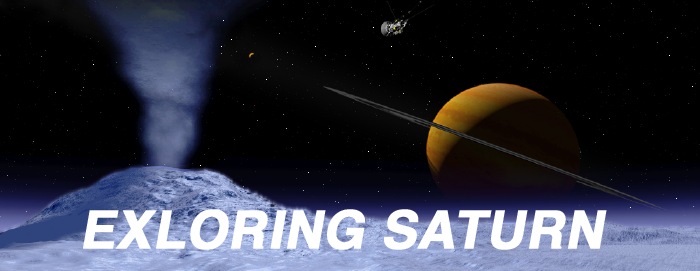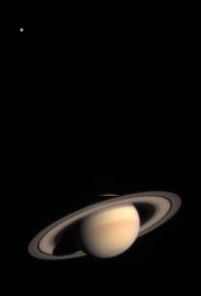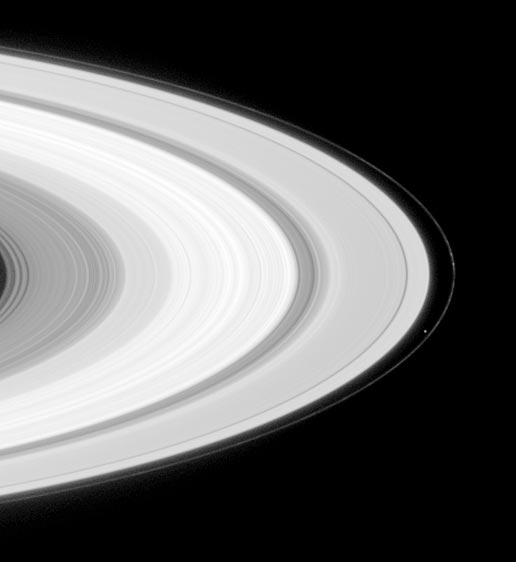 |
|||||||
| One of the Most Complex and Ambitious Ventures in the History of Space Exploration | |||||||
| Saturn | Rings | Moons | Titan | Cassini | Science | Huygens | Resources |
THE LATEST CASSINI NEWS FROM SATURN »»
IMPORTANT CASSINI FINDINGS ABOUT MOONS AND RINGS »»
MOONS »» RINGS »» MOONS OF THE SOLAR SYSTEM »»
Saturn, the second largest planet in our Solar System, is like a planetary system with an entire system of its own — including spectacular rings, the second largest moon in the Solar System, and the second greatest collection of moons in the Solar System.
The tiny white dot at upper left in this Cassini photo is the giant moon Titan 760,000 miles from the ringed planet Saturn at lower right.
The planet Saturn is surrounded by an enormous magnetic field — a magnetosphere, which, like a bubble, traps and holds electric particles.
Saturn is the sixth planet out from the Sun. Its system of rings and moons are a miniature model of the disc of dust and gas that formed the planets around the early Sun more than four billion years ago.
Saturn was visited by three spacecraft from Earth in the late 1970s and early 1980s.In fact, most of what we know about Saturn and its system of moons and rings was learned from those fly-bys.
- Pioneer 11 flew by in 1979
- Voyager 1 flew by in 1980
- Voyager 2 flew by in 1981
A great deal more is being learned now as Cassini, the fourth robot explorer from Earth, carries out its four-year mission investigating Saturn and its moon Titan.
Cassini. The spacecraft was launched in 1997 on a roundabout journey of 2.2 billion miles to Saturn. Cassini is the most instrumented and scientifically-capable interplanetary probe ever flown. The project is the result of the best technical efforts of 260 scientists from the United States and 17 European nations. OTHER INTERPLANETARY PROBES FROM EARTH »»
The international Cassini-Huygens mission is a complex four-year tour of Saturn, including the planet's majestic rings and 31 known moons. There are 12 instruments on the Cassini orbiter and six on the Huygens probe. The sophisticated science instruments aboard the spacecraft are sending back data and images of Saturn's rings, icy satellites, the magnetosphere, and Titan, the planet's largest moon.
Huygens. One of the most powerful scientific instruments carried to Saturn by Cassini was the Huygens probe itself. Huygens housed half a dozen sensitive instruments to study the atmosphere and surface of Saturn's giant moon Titan.
After Huygens was released from Cassini to drop on Titan, its camera collected more than a thousand images of Titan's surface and clouds. Another instrument used radio signals to measure Titan's winds. Three sensors analyzed the moon's atmosphere. Huygens survived the landing on January 14, 2005, to photograph and measure Titan's surface.
COULD CASSINI BE NASA'S LAST MEGA-MISSION? »»
Rings
While three other gas planets – Jupiter, Uranus, Neptune – have rings, Saturn's are the largest. They are less than six-tenths of a mile thick, but they span up to 175,000 miles.
Sizing them up. Made up of billions of ice and rock particles, the rings range from small pieces to chunks as big as houses. The density of particles within and between the rings varies.
The rings are not perfectly circular and the gaps between them are not empty. The rings are relatively close to each other, except for the Cassini Division, which is a 2,920-mile-wide gap. Each ring orbits at a different speed around the planet.
The rings are named alphabetically in the order in which they were discovered.
Whence the rings? Cassini, which started its 76 orbits around the Saturn system with an opening pass through the gap between the planet's F and G rings, is helping us understand how rings formed and how they hold their orbits. Could they be pieces of shattered moons, or even comets or asteroids that broke up approaching the planet?
The rings are a hazardous area. Particles unseen from Earth could damage Cassini, so the spacecraft used its high gain antenna as a shield against small objects as it whipped through the ring plane.
LIST OF SATURN'S RINGS »»
A moon is a natural satellite rotating around a planet. European astronomer Christiaan Huygens in 1655 discovered Saturn had a large moon, which he named Titan. Previously, only Earth and Jupiter were known to have moons.
Moons
Today, we know there are many moons. In fact, only the planets Mercury and Venus do not have any moons. By comparison, we see that Saturn has nearly three dozen. Earth has one moon and Mars has two. Jupiter has the most moons of any planet. Saturn is second.
The largest moon in the Solar System is Jupiter's Ganymede with a diameter of 3,280 miles. That's larger than either of the planets Mercury and Pluto. Saturn's moon Titan is the second largest in the Solar System with a diameter of 3,200 miles, half again as large as Earth's Moon. Titan also is larger than Mercury and Pluto.
Titan's orbit is about 745,000 miles from Saturn. That's about three times as far away from the planet as our Moon is from Earth. It takes Titan about 16 days to complete a full orbit around the planet.
Most of Saturn's moons have names from Greek mythology, such as Enceladus, Hyperion, Pandora or Prometheus. The recently discovered moons have yet to receive names and are known by numeric labels from their year and order of discovery.
Some of the Saturn moons, like Pan, Atlas, Prometheus, and Pandora, are thought to be shepherd moons that herd the small particles orbiting Saturn into distinct rings. Others produce wavy, twisting patterns in the rings.
Close encounters. During the mission, Cassini will have 52 close encounters with seven of Saturn's 33 moons. LIST OF SATURN'S MOONS »»
Saturn's moons come in various sizes and shapes.Some of Saturn's moons may have been formed billions of years ago. Could others be fragmented parts of some bigger body?
- Some have surfaces that seem porous with icy craters, ridges and valleys.
- The terrain of others seems irregular, even corrugated.
- Some may be big rocks covered by complex organic materials like the dark substances found in primitive meteorites
Each of Saturn's known moons is unique. Here are some examples:
- Mimas is tiny, only 244 miles wide, but it has an enormous crater — a hole one-third as wide as the moon itself probably caused by a meteorite. A peak in the center of the crater is two-thirds the height of Mt. Everest, which is the highest point on Earth.
- Tethys has a canyon running three-quarters of the way around its surface. That means it may once have split almost in half.
- Dione and Rhea have wispy white markings on one side.
- Enceladus has a very bright surface making it one of the shiniest objects in the Solar System. It may have active water volcanoes. About as wide as Arizona, the moon is covered with water ice that reflects sunlight like freshly fallen snow. It's quite cold at about –330° Fahrenheit. Could volcanoes on Enceladus erupt and send up the icy particles that form Saturn's E-ring? Would they then snow continuously back down onto the moon's surface?
- Hyperion is oddly shaped and the length of its day is constantly changing.
- Iapetus is half bright and half dark.
- Pan is a very tiny moon with a diameter of only about 12 miles.
- Janus and Epimetheus switch orbits every few years, alternating which is closer to Saturn.
- Atlas, Pan, Pandora, Prometheus and others are shepherd moons that herd particles orbiting Saturn into rings.
- Titan is the only moon in the Solar System with a dense atmosphere. The atmospheric pressure near the surface is about 60 percent greater than Earth's. That compares with what a scuba diver on Earth feels under 20 feet of water. Titan's surface temperature is a cold –292°F. That's –180°C.
- The others are Phoebe, Helene, Telesto, Calypso, and 15 yet to receive names.
Lists of Natural Satellites and Rings around Saturn
Rings of Saturn RING DISTANCE
kilometersWIDTH
kilometersD 63,500 11,000 C 74,500 17,600 B 92,100 25,300 Cassini 117,400 4,700 A 122,100 14700 F 140,210 - G 165,800 8,000 E 180,000 300,000
Moons of Saturn NAME DISCOVERED Iapetus 1671 Rhea 1672 Tethys 1684 Dione 1684 Titan 1655 Mimas 1789 Enceladus 1789 Hyperion 1848 Phoebe 1898 Janus 1966 Atlas 1980 Prometheus 1980 Pandora 1980 Epimetheus 1980 Telesto 1980 Calypso 1980 Helene 1980 Pan 1990 Ymir 2000 Paaliaq 2000 Siarnaq 2000 Tarvos 2000 Kiviuq 2000 Ijiraq 2000 Thrym 2000 Skadi 2000 Mundilfari 2000 Erriapo 2000 Albiorix 2000 Suttung 2000 S/2003 S 1 2003
Cassini-Huygens is a project of NASA, the European Space Agency and the Italian Space Agency. NASA's Jet Propulsion Laboratory (JPL), a division of the California Institute of Technology at Pasadena, manages the mission for NASA's Office of Space Science, Washington, D.C. The Cassini orbiter and its two onboard cameras were designed, developed and assembled at JPL. The imaging team is based at the Space Science Institute, Boulder, Colo.
| Top of this page | Saturn main page | The Planet | The Rings | The Moons | Solar System |
| Cassini probe | Cassini Science | Titan moon | Huygens | Internet Resources | |
| STO Cover | Search STO | Questions | Copyright 2005 Space Today Online | ||

